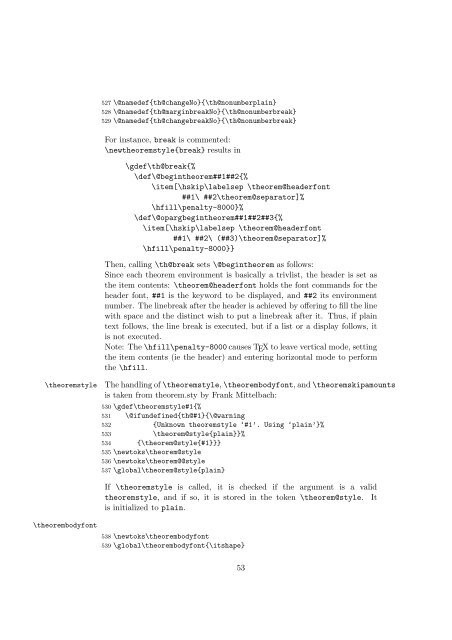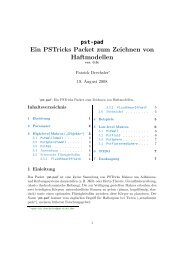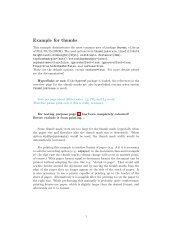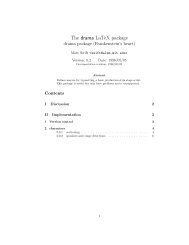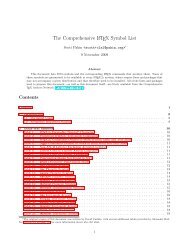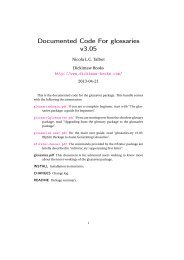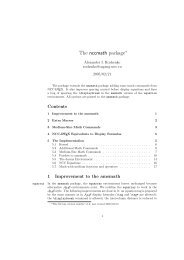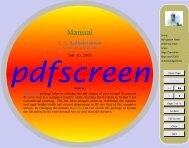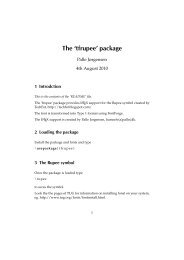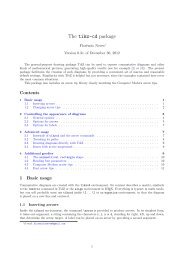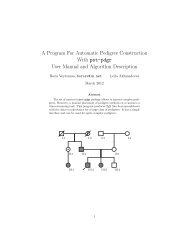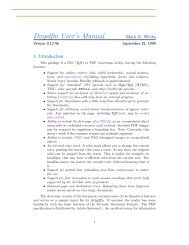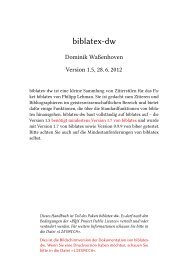ntheorem.pdf. - Mirrors.med.harvard.edu
ntheorem.pdf. - Mirrors.med.harvard.edu
ntheorem.pdf. - Mirrors.med.harvard.edu
Create successful ePaper yourself
Turn your PDF publications into a flip-book with our unique Google optimized e-Paper software.
527 \@na<strong>med</strong>ef{th@changeNo}{\th@nonumberplain}<br />
528 \@na<strong>med</strong>ef{th@marginbreakNo}{\th@nonumberbreak}<br />
529 \@na<strong>med</strong>ef{th@changebreakNo}{\th@nonumberbreak}<br />
For instance, break is commented:<br />
\newtheoremstyle{break} results in<br />
\gdef\th@break{%<br />
\def\@begi<strong>ntheorem</strong>##1##2{%<br />
\item[\hskip\labelsep \theorem@headerfont<br />
##1\ ##2\theorem@separator]%<br />
\hfill\penalty-8000}%<br />
\def\@opargbegi<strong>ntheorem</strong>##1##2##3{%<br />
\item[\hskip\labelsep \theorem@headerfont<br />
##1\ ##2\ (##3)\theorem@separator]%<br />
\hfill\penalty-8000}}<br />
Then, calling \th@break sets \@begi<strong>ntheorem</strong> as follows:<br />
Since each theorem environment is basically a trivlist, the header is set as<br />
the item contents: \theorem@headerfont holds the font commands for the<br />
header font, ##1 is the keyword to be displayed, and ##2 its environment<br />
number. The linebreak after the header is achieved by offering to fill the line<br />
with space and the distinct wish to put a linebreak after it. Thus, if plain<br />
text follows, the line break is executed, but if a list or a display follows, it<br />
is not executed.<br />
Note: The\hfill\penalty-8000causes TEXtoleave vertical mode, setting<br />
the item contents (ie the header) and entering horizontal mode to perform<br />
the \hfill.<br />
\theoremstyle Thehandlingof\theoremstyle,\theorembodyfont,and\theoremskipamounts<br />
is taken from theorem.sty by Frank Mittelbach:<br />
\theorembodyfont<br />
530 \gdef\theoremstyle#1{%<br />
531 \@ifundefined{th@#1}{\@warning<br />
532 {Unknown theoremstyle ‘#1’. Using ‘plain’}%<br />
533 \theorem@style{plain}}%<br />
534 {\theorem@style{#1}}}<br />
535 \newtoks\theorem@style<br />
536 \newtoks\theorem@@style<br />
537 \global\theorem@style{plain}<br />
If \theoremstyle is called, it is checked if the argument is a valid<br />
theoremstyle, and if so, it is stored in the token \theorem@style. It<br />
is initialized to plain.<br />
538 \newtoks\theorembodyfont<br />
539 \global\theorembodyfont{\itshape}<br />
53


